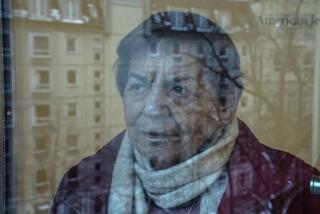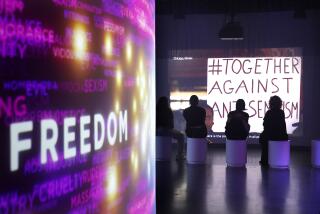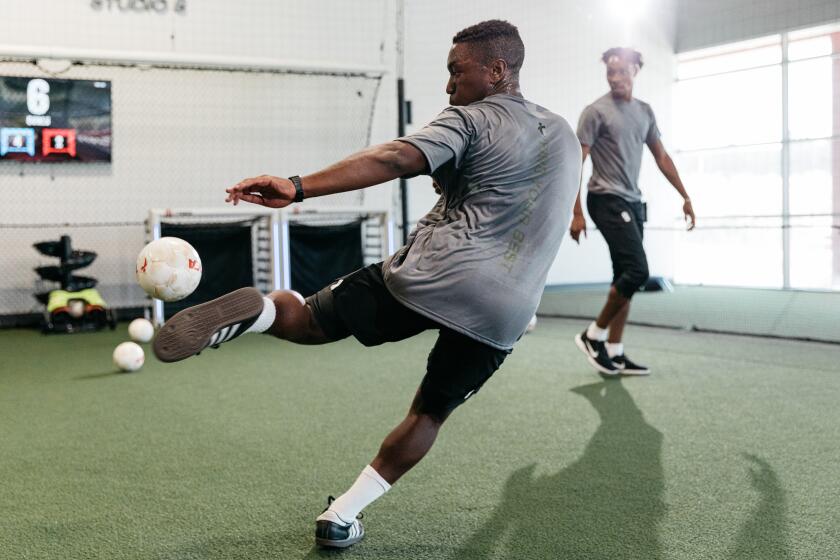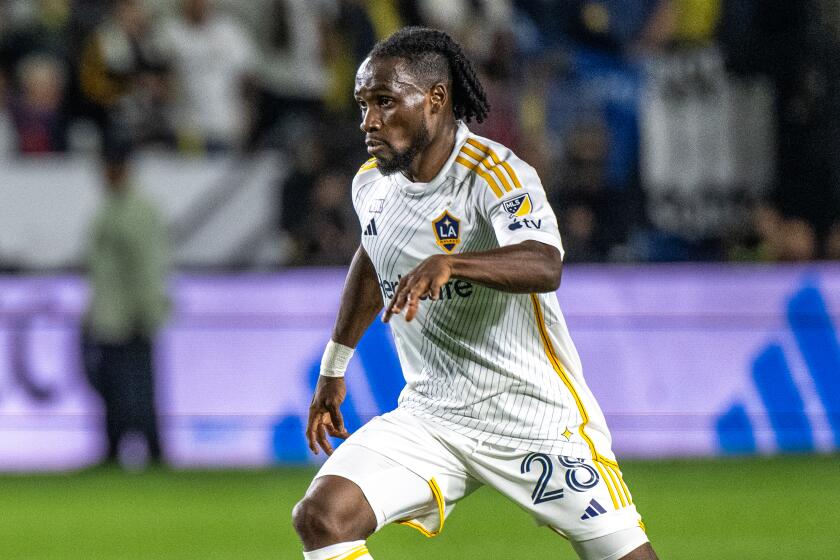The Jew who built Bayern Munich, then saved it after surviving the Holocaust
At 95, Uri Siegel’s eyesight is fading but his memory is still sharp. So while he struggles to see what’s right in front of him, he has a keen focus on the past.
And that serves him well when discussing German soccer power Bayern Munich.
It was Siegel’s uncle, a Holocaust survivor named Kurt Landauer, who laid the foundation that has supported Bayern’s rise from the ashes of postwar Germany. Siegel remembers going to games with his uncle and climbing eight rows up the concrete grandstands to their seats in the team’s old, unadorned stadium.
Without Landauer, the once-provincial team would not have won 27 national titles or eight European crowns. Without him the Bundesliga would not be the best-attended professional sports league in the world after the NFL. Without him, there might not even be a Bundesliga.
“He was a pioneer,” Siegel says. “There were certain things he introduced to the organization. Like internationalism, which is now, of course, the thing.
“And there was some honesty to him that is a little bit hard to find.”
Yet for decades after his death any mention of Landauer, a newspaper advertising executive who served four terms as club president before and after World War II, was also hard to find. Because for all his success in modernizing Bayern Munich — and by extension, all of German soccer — acknowledging the contributions of Landauer, a Jew, stirred difficult memories of the darkest period in the country’s history.
That changed with the publication of a newspaper story on Siegel, who recounted his uncle’s past. One of the club’s fan groups quickly seized on the story, producing T-shirts with Landauer’s likeness, unfurling banners in his honor during games and organizing soccer tournaments in his name.
More than 50 years after his death, Landauer’s story of resilience, redemption and forgiveness was inspiring a new generation while forcing the club to take a deeper look into its past.
Soon Bayern Munich was recognizing Landauer in its museum at Allianz Arena. And on what would have been their former president’s 125th birthday, club officials laid a red-and-white wreath at the base of block eight, room four of the Dachau concentration camp.
Landauer’s room.
“That was the first time that the club dealt so directly with the topic or staked out an official position. Landauer’s birthday was a turning point,” says Simon Mueller, a member of the Ultra supporters group that resurrected Landauer’s memory.
“It’s important that he was Jewish. And it’s important that he not be forgotten.”
::
Dachau, built on the grounds of an abandoned munitions factory about 10 miles north of Munich, was the original Nazi concentration camp. By the end of the war, the Germans and their allies had established more than 40,000 other camps and incarceration sites where 11 million people, more than half of them Jewish, perished. Most of those camps were modeled after Dachau.
On a recent December morning Dachau is silent and haunting. A gentle snowfall paints the parade grounds and the 32 austere wooden barracks a bright white. Of the estimated 200,000 prisoners interned in the five-acre camp, more than 32,000 were known to have died here, their bodies burned in a red-brick crematorium, buried in mass graves or stacked like cords of wood outside the barbed-wire fences.
This is where Landauer was brought in November of 1938, when he was arrested and charged with only one crime: being a Jew.
Landauer wasn’t a particularly religious person, preferring women, beer, roast pork and soccer — not necessarily in that order – over temple service. Had he been Catholic, he would have been a model citizen. But in Munich, birthplace of the Nazi Party, Bayern was known as a Jewish club. (Benno Elkan, who signed the club’s founding charter, fled the Nazis for London where he became an artist, eventually designing the four-ton menorah that stands outside Israel’s Knesset.)
Starting the process of returning to a civilized society would never have been possible without people like Landauer.
— Dirk Kamper
And under Landauer, who, Siegel says, paid little mind to religion or ethnicity, the Jewish influence grew, peaking in 1932 when Richard Kohn, an Austrian Jew, coached Bayern to its first German championship. When Landauer and Kohn returned home from Nuremberg after the game, tens of thousands of people welcomed them.
Less than a year later, after Nazi leader Adolf Hitler had been appointed chancellor, Kohn fled to Switzerland while Landauer and Otto Beer, head of the club’s youth program, resigned their posts.
Beer and his family perished in the Holocaust as did all but one of Landauer’s siblings. Landauer spent 33 hellacious days in block eight, room four at Dachau before being released when it was discovered he had been a decorated soldier on the front lines in France during World War I. He spent the rest of the Nazi Reich in Switzerland.
Bayern wouldn’t win another German title until 1969.
::
Siegel lives alone on a quaint Munich street lined by yellow and red brick buildings and split down the middle by trolley tracks. Bookshelves and paintings line the walls of the large corner apartment where he has spent the last 50 years; a plaque near the door reads “Uri Siegel, lawyer.”
His failing eyes are sensitive to light, he says, so he spends much of his time in the twilight, drawing heavy storm shutters to block out the gray morning light. As Kurt Landauer’s last living relative, it has fallen to Siegel to tell his uncle’s story – even if it’s a story that, for decades, interested no one.
Bayern Munich chairman Karl-Heinz Rummenigge, the team’s star striker in the 1970s and ’80s, said he never heard Landauer’s name during his playing days.
“He wasn’t ignored,” Rummenigge said. “He simply disappeared from the club’s history.”
That changed in 2003, when a curious writer knocked on Siegel’s door. That original story, in the German newspaper Die Zeit, was followed by a feature film, two documentaries and a book, among other projects. Landauer’s story, which had never been hidden, was suddenly out in the open.
But it really began to spread after the Schickeria — a rabid Bayern Munich fan group whose name is meant as an ironic nod to a term once used to describe Munich’s fashionable elites — adopted Landauer.
“The fact that the fans take him as an idol, that makes me very proud,” Siegel says.
The Schickeria, an independent organization not affiliated with the club, was rewarded for that when the German soccer federation presented the group with the Julius Hirsch Prize – named after the first Jewish player to represent the German national team who was murdered during the Holocaust – in recognition of its “outstanding example of integration and tolerance.”
Mueller, a 35-year-old consultant for a small business and a Schickeria member, said the original aim when the group embraced Landauer was much more humble: to make the stadium safe for families and their children.
“When I came to the stadiums in the ’90s, you had a lot of right-wing people. In Munich, the culture was open to right-wing things,” Mueller says. “The idea of Kurt Landauer, what he stands for now, is very important. But for me it’s important what he means for the people in the stands. It’s important for us not to go back to right-wing ideas.”
Mueller’s group never banned anyone, nor asked any fan to leave. But they wore Landauer T-shirts and waved huge banners with his face on them.
“When the fans in the stands do something and the TV cameras show it, the whole country takes notice,” he says. “The fans are saying, ‘this man is important.’”
Soon the homophobic and racist remarks ceased. And though the Simon Wiesenthal Center says anti-Semitism remains a plague in global soccer, in the largest stadium in the city that gave rise to the Nazis, it is no longer a problem.
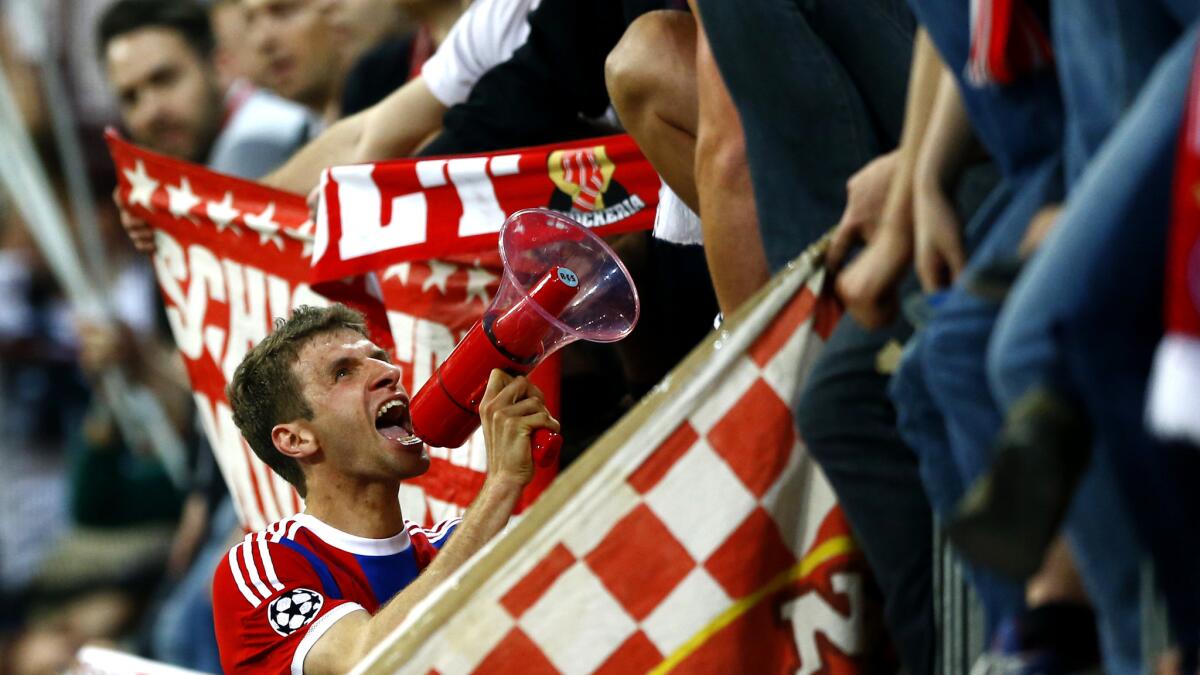
The Schickeria’s homage to Landauer involved more than just T-shirts and banners, though. The group carried his story throughout Europe, playing in soccer tournaments that matched supporters’ groups from teams all over the continent.
“All these tournaments, you have political messages and lectures about some political topics,” Mueller says. “We wanted to have something like that in Munich too. We decided to name our tournament the Kurt Landauer Tournament.”
The event, which included somber visits to Dachau, grew so quickly it overwhelmed organizers and had to be suspended last year.
“The thing about Landauer is, you have this message. You also have the passion for the club,” Mueller says.
“It’s that not easy to talk against [him] because he’s that important for the club.”
For Mueller, it’s less Landauer’s religion and more his devotion to Bayern Munich — especially after the war, when he came back to a country and a club that was in shambles and helped both rise again — that cemented his place among the Bayern faithful.
“When Landauer returned to Munich, he had a ticket to the U.S. in his pocket,” he says. “But he decided to stay, helping to build a new stadium for Bayern and getting league licenses for all of Munich’s clubs.”
::
Landauer wouldn’t recognize modern German soccer, with its massive and palatial stadiums, global TV deals and multimillion-dollar players. Yet you can draw a straight line from many of his innovations to the way clubs operate today.
The team’s highly successful youth program was a Landauer innovation, as were the team’s policies of fiscal responsibility, corporate sponsorship and an international roster. To Rummenigge, he was German soccer’s first professional president.
Prophets, however, often find the people hardest to convince are those closest to them, so four years after returning to Munich to begin his fourth term as club president, Landauer was voted out of office.
Without his leadership, Bayern quickly ran up massive debts and was relegated to German soccer’s second tier. In 1961 Landauer died and, a short time later, so did memories of him, with most people finding it easier to ignore the Holocaust rather than exalting its survivors, no matter how deserving.
More than five decades later that legacy has been exhumed, dusted off and given a place of honor by the club which, spurred in part by its fans, named the courtyard in front of its stadium Kurt Landauer Platz.
“It’s a memorial as well as a statement,” said Rummenigge, who called Landauer “an example of integration, tolerance and reconciliation.”
Mueller, the Schickeria member, says it’s those final three traits that make Landauer’s example one worth emulating at a time when segregation, intolerance and dissension are once again on the march, in Germany and elsewhere.
Dirk Kamper, author of the 2014 book “Landauer: The Man Who Made FC Bayern,” agrees, saying Landauer likely saved more than a soccer team.
“Starting the process of returning to a civilized society would never have been possible without people like Landauer,” he said. “These people, although they had been beaten and tortured, returned to Germany and started up again. There were only a few. And Landauer was not one of the most famous.
“But with his work he was one of the most important persons to turn this country on a right way. Not because he talked about it. Simply because he did it.”
Follow Kevin Baxter on Twitter @kbaxter11


